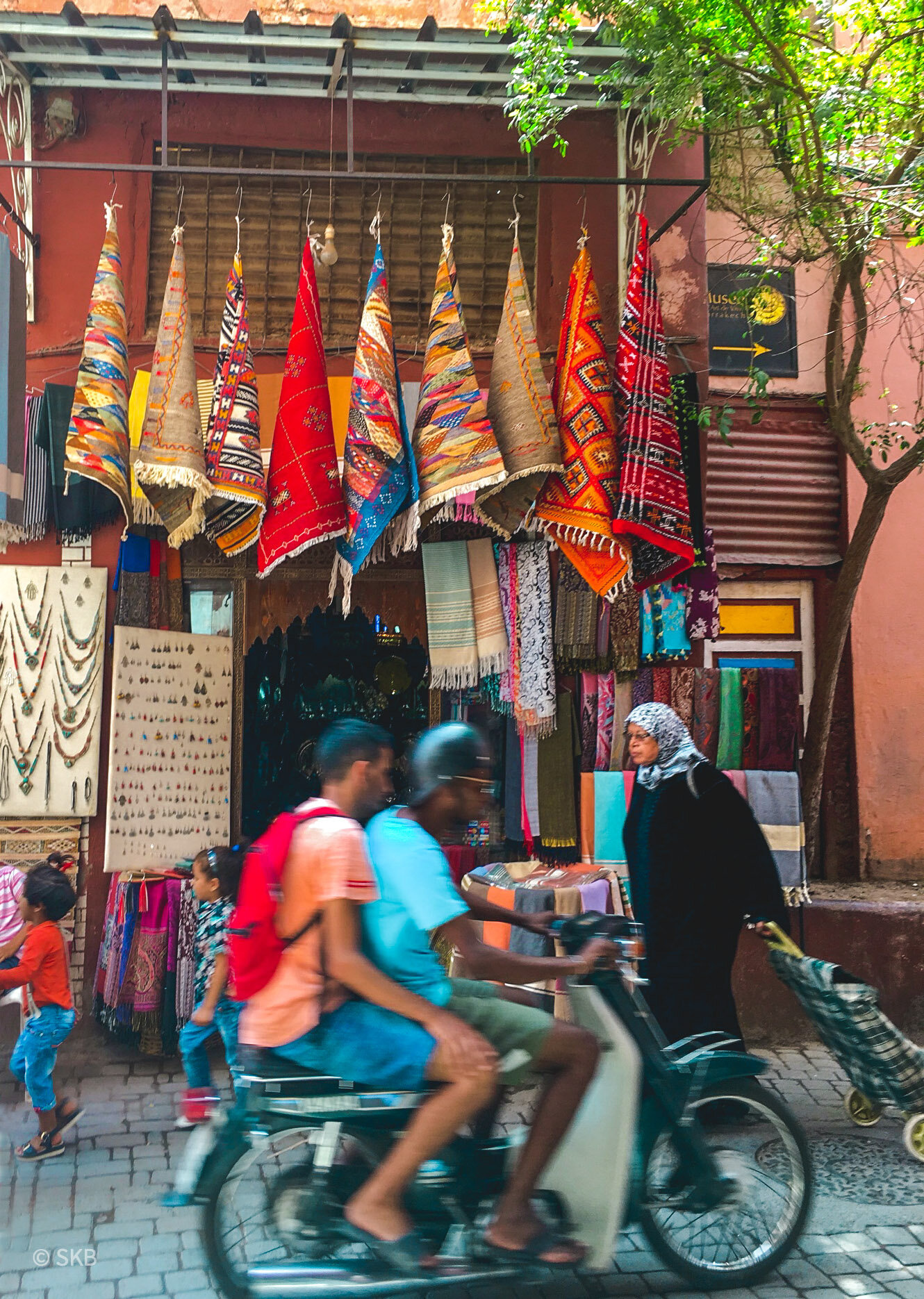Travel Journal: In the Medina, Marrakech
Sunset over the red city: Marrakech.
Looking out over the rooftops of Marrakech at sunset, it’s immediately obvious why this ancient place is known as the red city.
As the sun slowly sinks behind the horizon, the sky blushes crimson and pink, silhouetting this city of contrasts. Satellite dishes and TV ariels perch on flat-roofed, clay buildings; palm trees grow from a landscape parched by the desert sun and, far in the distance, the High Atlas Mountains shine brightly in that golden hour. This is the opening act of a show the red city puts on every night - and it’s not one to be missed.
A Very Brief History of Marrakech
The city of Marrakech was founded in the mid 11th century, although the area has been inhabited by Berber farmers since neolithic times. Berber culture, crafts and languages are prominent, but occupation and influence from Ottoman, French, Spanish and Portuguese powers across the centuries has created the blended culture, architecture and atmosphere that fascinates and draws so many to travel to the city today. These layers of influences are what makes Marrakech such an absorbing destination - wherever you turn, there is something new to see, understand, taste, smell and touch. In so many travel guides Marrakech is labelled as a feast for all the senses, and I can’t think of a better way of putting it; the city demands your constant attention. It is tiring in the very best sense of the word.
Marrakech Medina
The ancient part of the city is the medina, much of it still surrounded by walls which have been standing since they were built in the 12th century. This was the heart of the original city, and stepping into this tangle of streets and alleyways bursting with markets is like stepping into another world. Stalls of handmade crafts line the narrow passageways - leather bags, hand-woven blankets and rugs, exquisitely decorated clay tiles and ornaments are piled up out of reach, with the cries of local producers emerging from behind their wares. Creating a plan or following a map through the winding lanes is futile; to truly experience the magic of the place you must follow your senses. As someone who gets lost - a lot - it was daunting, but soon I adjusted to the rhythm of the place. The smell of spices wafting around a corner, a flash of colour, enchanting music from a street performer - these are markers to map your way through the medina. If you slip into believing you have been transported back in time, it won’t be long before the buzz of a moped weaving in and out of pedestrians brings you back to reality.
Watch out: two men balanced on a scooter appear from nowhere, whizzing by in an instant.
Their blurred figures race through the frame, dodging shoppers and children against the backdrop of this beautiful market stall. It has come to be one of my favourite images from the trip, capturing a slice of the non-stop action in the medina.
If City Walls Could Talk…
The old city walls keep this web of streets contained from modern Marrakech. The ramparts of Marrakech are impossible to miss as you enter - between 8m and 10m tall, these walls surround the medina and until the early 20th century the 10 gates were locked each night. They are distinctively marked with holes in the surface, revealing the process of how they were constructed.
Working with the red clay and mud from the region, labourers built the wall from the bottom to the top, packing the earth tightly. As the structure got higher, wooden beams would be inserted as scaffolding, allowing them to always be working on the top section of the wall. When the materials had settled these beams were removed and moved upwards to the next level, leaving the holes in place today. This type of construction has to be continually restored as it is at the mercy of the elements, and so these little holes still play an important role in that process. (Travelling with an architect on this trip threw up some fascinating facts!)
Faith & Architecture in Marrakech
Towering over the height of the city walls is the minaret of the Kutubiyya Mosque, over 75m tall and covered in intricate geometric patterns and arches. It is said to have been build by Spanish captives and inspired by a blending of Andalusian Islamic architecture with Saharan and West African styles. The call to prayer echoes out over the medina five times a day, a prominent reminder of another dominating cultural force in the city: religion.
Islam is the main faith in Morocco and has a great influence on local culture and customs. We visited during a religious festival - by accident rather than design - and it was wonderful way to discover more about the religion and how locals live. Most will be familiar with the holy month of Ramadan, where followers do not eat during daylight hours, leading to a buzz about the city after sunset.
Our visit coincided with Eid al Kebir, the feast of sacrifice, commemorating Abraham’s willingness to sacrifice his son. In Marrakech it is traditional for families to sacrifice a sheep on this day, sharing a third of it as their holiday feast, giving a third to friends and relatives and donating a third to those in need. We learnt all of this from a young man who was driving a wagon of nervous sheep through the narrow streets, selling them door-to-door to celebrating families.
Timeless Tiles…
The Islamic school of Ben Youssef Madrasa brings together these architectural and religious themes and was one of my highlights of visiting Marrakech. Tucked away in the winding lanes of the medina, the school was founded in the 14th century and became one of the largest and most important Islamic schools in North Africa. Formal (and rather bleak-looking) study rooms contrast with a stunning central courtyard decorated with beautiful Moroccan mosaics, also known as Zellij tile-work.
Zellij is pretty trendy in the Western World. The style is characterised by colourful geometric patterns and was established by Islamic artists as a form of creative expression without depicting living things, as is taught by Islamic law. Other examples of Zellij tile-work in Marrakech can be found in the ornate complexes of the Sadiaan Tombs and Bahia Palace.
The Gardens of Marrakech
Whilst much of the charm of Marrakech is in its tightly packed streets, there are several natural oases where you might forget you are in a city and enjoy peaceful surroundings. The city’s many gardens sprung up thanks to an ancient underground irrigation system that brings in water from the High Atlas Mountains - these systems are still in use to this day. There are many gardens within reach of the city such as those at the Bahia Palace, but perhaps the most well known is the Jardin Majorelle. The botanical garden is home to plants from around the world, and is Insta-famous for selfie-worthy bright blue and yellow walls, fountains and being a source of inspiration for French fashion designer Yves Saint Laurent, who also was so enchanted with the place he bought the land to save it from development.
Monsieur Laurent is one of a number of famous names to list the city as a favourite haunt, and in the 1960s it became somewhat of a “hippy” destination, attracting big names such as The Beatles and The Rolling Stones. Perhaps my first memory of the destination is as a young child in the 90s, seeing the exploits of Patsy, Edina and Saffron in the city on an episode of the BBC’s Absolutely Fabulous - fortunately I encountered many more accurate portrayals of Moroccan culture as I grew up!
Tagine Dreams
A prominent manifestation of Moroccan culture in my life before I made my trip was Moroccan food, thanks largely to a fantastic restaurant in Leicester called Marrakech - now sadly closed. The food of the region is a glorious mix of Arabic, Berber, European and Middle Eastern cuisines and flavours; think rich spices, slow cooked meat, fragrant cous cous, sweet dried fruits, delicate pastries and a tea tradition to rival the English.
The most famous dish is tagine, a stew-like meal prepared with vegetables, meat or fish which is served at almost every eatery in the city, from high-end restaurants to road-side stalls. The name tagine actually refers to the pot that the dish is cooked in - a conical clay pot which traps steam allowing the contents to cook evenly. You’ll see them, painted brightly and piled up on market stalls across the country, enticing home-cooks to buy them.
The tagine dates back to Berber traditions of slow cooking tough cuts of meat over fires in the clay dish, and the flavours are now synonymous with Morocco. When it comes to eating, Moroccans usually sit around the pot and eat together, dunking bread in the delicious sauce - it is a time for family, community and togetherness. This was exemplified at our Riad, where the family who ran the place invited us to dine in one of the evenings*. We were presented with a home-cooked meal of oh-so-tender meat and vegetables, and memories to last a lifetime.
The Street Food Experience of Jemaa el-Fnaa
Nothing exemplifies this community spirit at mealtimes more than the city’s main square, Jemaa el-Fnaa - reportedly the busiest square in Africa (something I read which I can’t corroborate, but I wouldn’t be surprised if it is true!). The street theatre kicks off in the early afternoon, with the hypnotising hum of snake charmers playing flutes to enchant reptiles and humans alike. Monkey handlers shout over their screeching charges and fortune tellers sit knowingly, waiting for you to approach. Carts surround the square, piled high with local oranges waiting to be squeezed to quench parched throats in the searing sunshine.
As evening descends the real noise begins, with Berber and Arabic musicians taking a seat on the cooling ground to tune up their instruments for a waiting crowd. Finally, the grills turn on and the smoke rises through a crowd of people and fluorescent lights - enter this hazy world and you will be quick to fall under its spell.
Taking a seat at the rows of benches here is to become part of the community. Market stall sellers jostle for your custom, locals point you to their favourite haunts and travellers swap stories over these tables. It’s time to make a choice and indulge - rows of sheep heads might not take your fancy, but colourful salads, sizzling grilled meats and vegetables and, of course, fragrant tagine is just a taste of what’s on offer.
To escape the melee, we often retreated to one of the cafes on the edge of the square after dinner, sipping mint tea on a roof terrace with the panoramic view of the market below. As the sun sets over the red city, this is the perfect place to sit back and enjoy the show.
The sun sets over the rooftops of Marrakech.
Where to Stay in Marrakech
We stayed in Riad Agathe and Spa. Riad’s are traditional Moroccan houses, and staying at one is like halfway between a hotel and a homestay. Riad Agathe is beautiful, with a central courtyard and pool with rooms around the edges. There’s a common dining room where you can request a home cooked meal, and there’s even a beautiful rooftop area to relax!
Check it out and book on TripAdvisor.*
Book on Booking.com*.
*Affiliate links. If you click through and book we will be paid a small commission for recommending you - there is no extra cost to you!
Related Content
Pin this blog post to read later…












